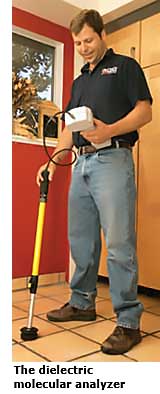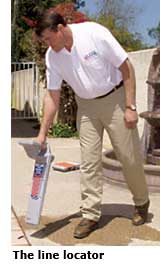Leak Detection Experts
 Richard Norse lives in a mid-century modern home in Orinda that is as different from an Eichler as Coke is from Pepsi. His home has many of the hallmark Eichler features—post-and-beam construction, lots of glass, and even an in-slab radiant heat system with piping that recently sprang a leak.
Richard Norse lives in a mid-century modern home in Orinda that is as different from an Eichler as Coke is from Pepsi. His home has many of the hallmark Eichler features—post-and-beam construction, lots of glass, and even an in-slab radiant heat system with piping that recently sprang a leak.
When a plumber broke the news of the leak last summer, Norse immediately telephoned the nearest franchise of American Leak Detection to quickly sniff it out.
The American Leak Detection technician called in was Jim Norman—friendly, and dressed in an Oakland A's cap, jeans, and t-shirt. Norman grabbed a tank of pressurized air out of the van, strode through the home's double doors, and headed straight to the radiant boiler closet.
Radiant heat works like an old-fashioned radiator set into a slab foundation. These days it is comprised of synthetic tubing, but virtually all of the Eichlers were originally built with either steel or—for the lucky ones—copper tubing. The piping is coiled through the site and a concrete slab is poured over it. A 3,000-square-foot home such as Norse's could have as much as 3,000 feet of tubing encased in its concrete floor.
Norman connects the air tank to the radiant system and opens the valve, beginning the process of pressurizing the thin-diameter tubing. As the air spills into the pipes, Norman begins scanning the floor with a device that is a throwback to some old science fiction movie.
This is an ultrasonic listening device, and it operates like a highly technical stethoscope. It's the size of a shoebox, with headphones and a square, metal microphone dangling on a chord. With its dials and buttons, the device looks like a period piece from the jet age - and it fits the aesthetic of the home nicely.

Norman dangles the microphone across the floor, searching for that rushing, bubbling sound of water and forced air escaping through a leak in the tubing. He walks through the wood-paneled hallway and into the living room with its sunken fireplace. His inspection of these parts is cursory, and he looks ahead to the spot in the foyer where a leak was detected some years before.
"If you get a weak spot in the slab, that tubing tries to hold the concrete together," Norman says. "This little entryway is holding these two slabs together." The 12-foot-wide foyer connects the two big slabs that support the main wings of the house. This is a likely spot for movement in the concrete, says Norman, and perhaps just enough to put stress on the tubing.
Sure enough, Norman discovers a crack running the width of the foyer, from the glass wall to the front threshold. He drags the microphone slowly along the crack and stops. Then Norman finds a 'loud spot,' but must wait for the sound of bubbles. The forced air can take an hour to work its way through the entire system. This is a sensitive point in the detection process. Norman must pinpoint the leak accurately or risk breaking up the floor in the wrong spot - a costly mistake.
Leak Detection's Dark Ages of 'Hunt and Peck'
Leak detection wasn't always easy. In the early days, its technology was linked more closely to a wing and a prayer than to the exact science that defines it today.
A duel probe device, what radiant heat expert Jerry Rothfeld calls a "glorified stethoscope," could be used the way an ultrasonic listening device is now, but it was far less sensitive. One probe was placed into each ear, allowing the user to roughly triangulate a leak. The device didn't work on carpet, though, nor could it pick up small or low-pressure leaks.
Tinker and Rasor, a San Gabriel, California leak detection equipment manufacturer, developed an early electronic listening device in the late 1940s, but such devices didn't come into widespread use in residential leak detection for another 40 years.
Before listening devices and thermal imaging systems, detecting a leak was often a case of guesswork tied to the 'hunt and peck' method. Often finding a leak meant waiting for a wet spot to appear. But when piping runs under the slab, as domestic pipes do in Eichlers, the water can pool under them instead of seeping up.
Fortunately for Eichler owners, their original radiant heat systems, according to Rothfeld, are "damn durable." If the slab doesn't shift and put pressure on the tubing, it can practically last forever, he said.
At last Norman narrows down his search to a single square of tile, and a familiar sound fills the headphones. He passes us the headset and releases the mute button on the listening device. A rush like that of a waterfall betrays a leak.




